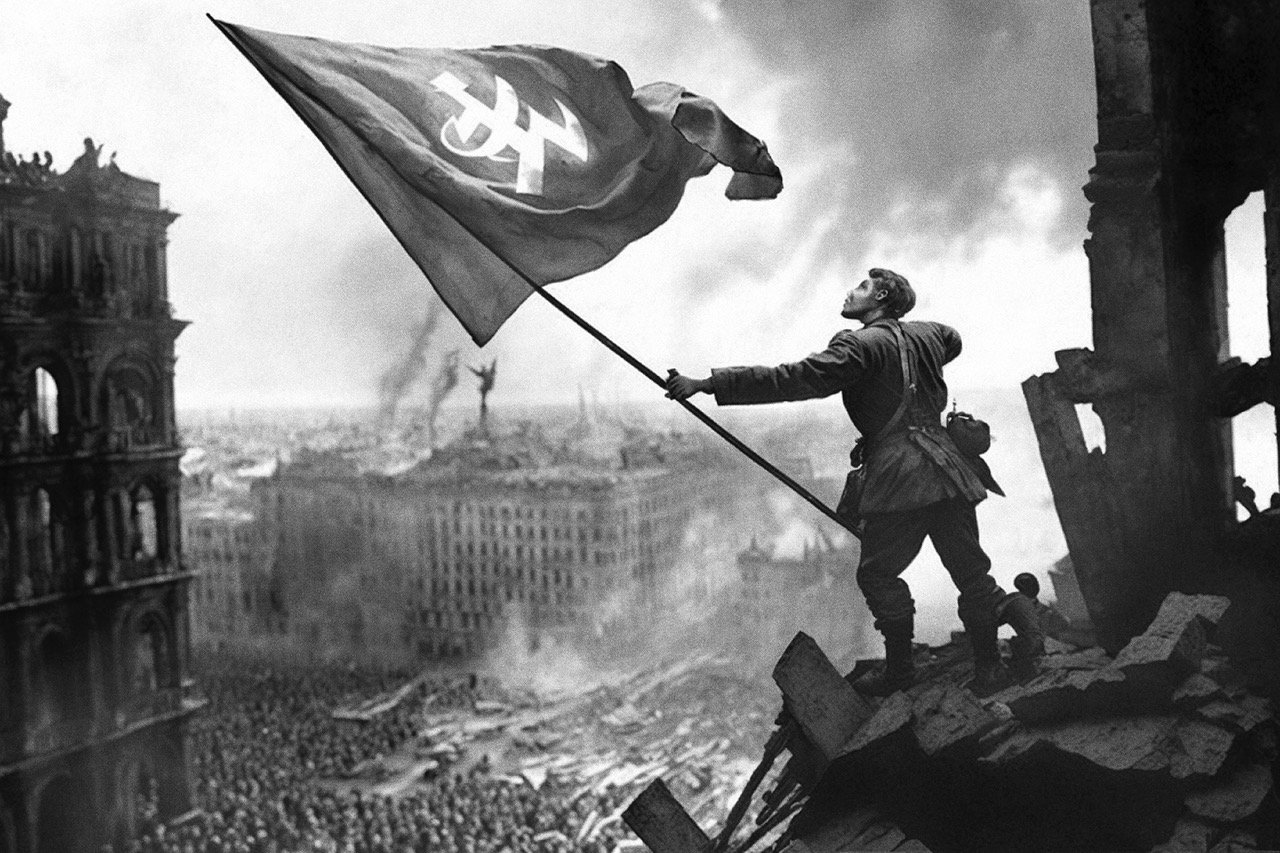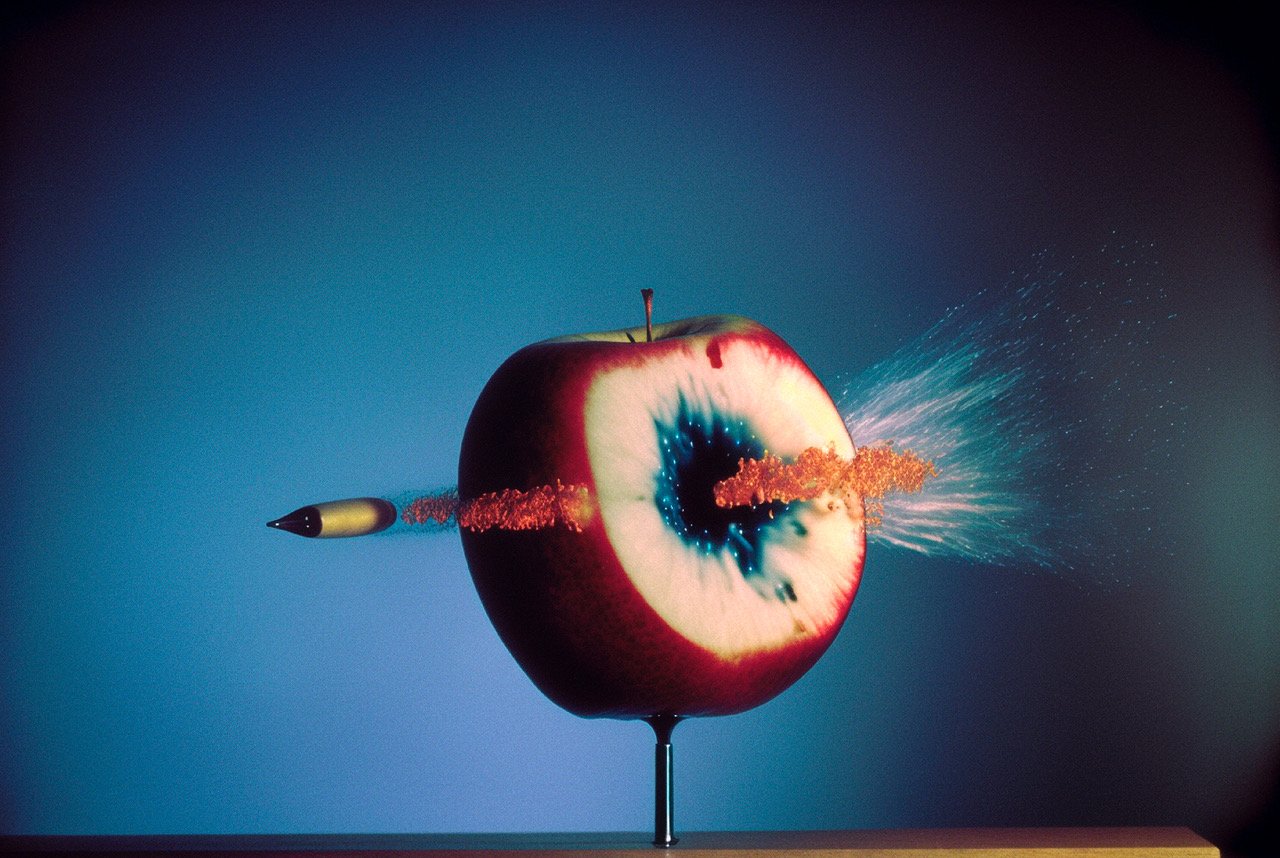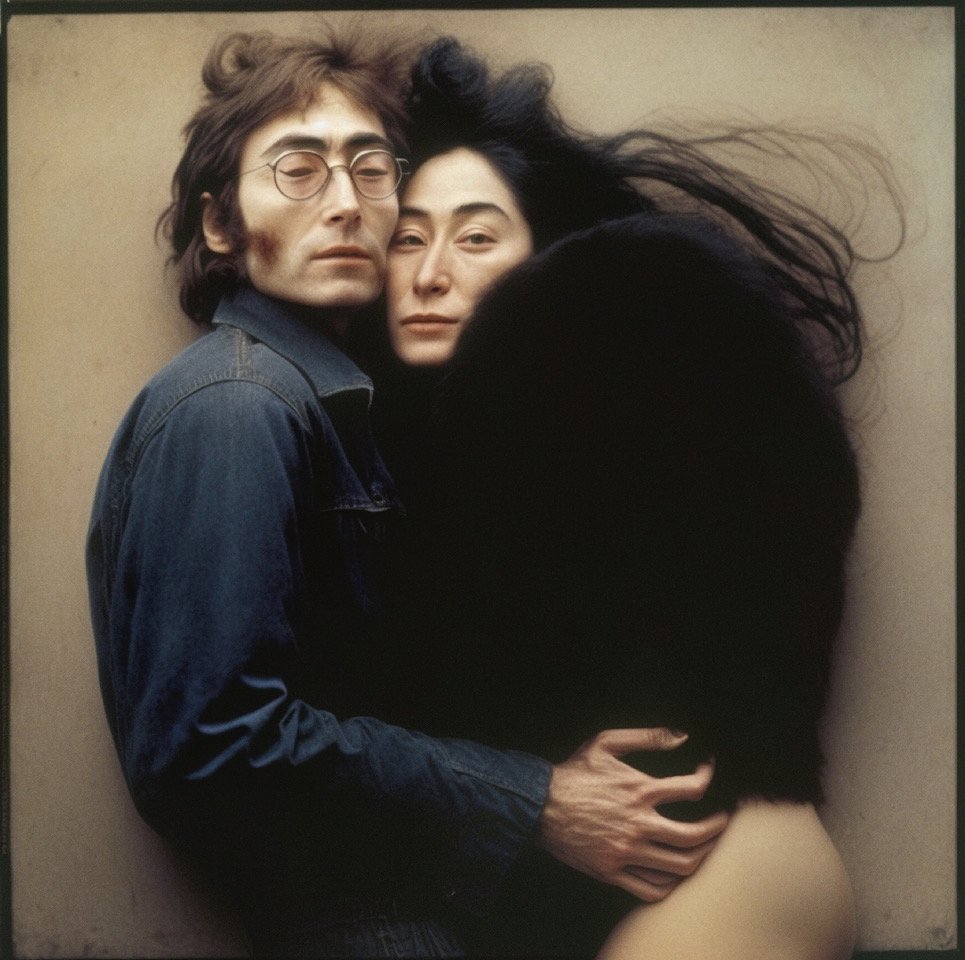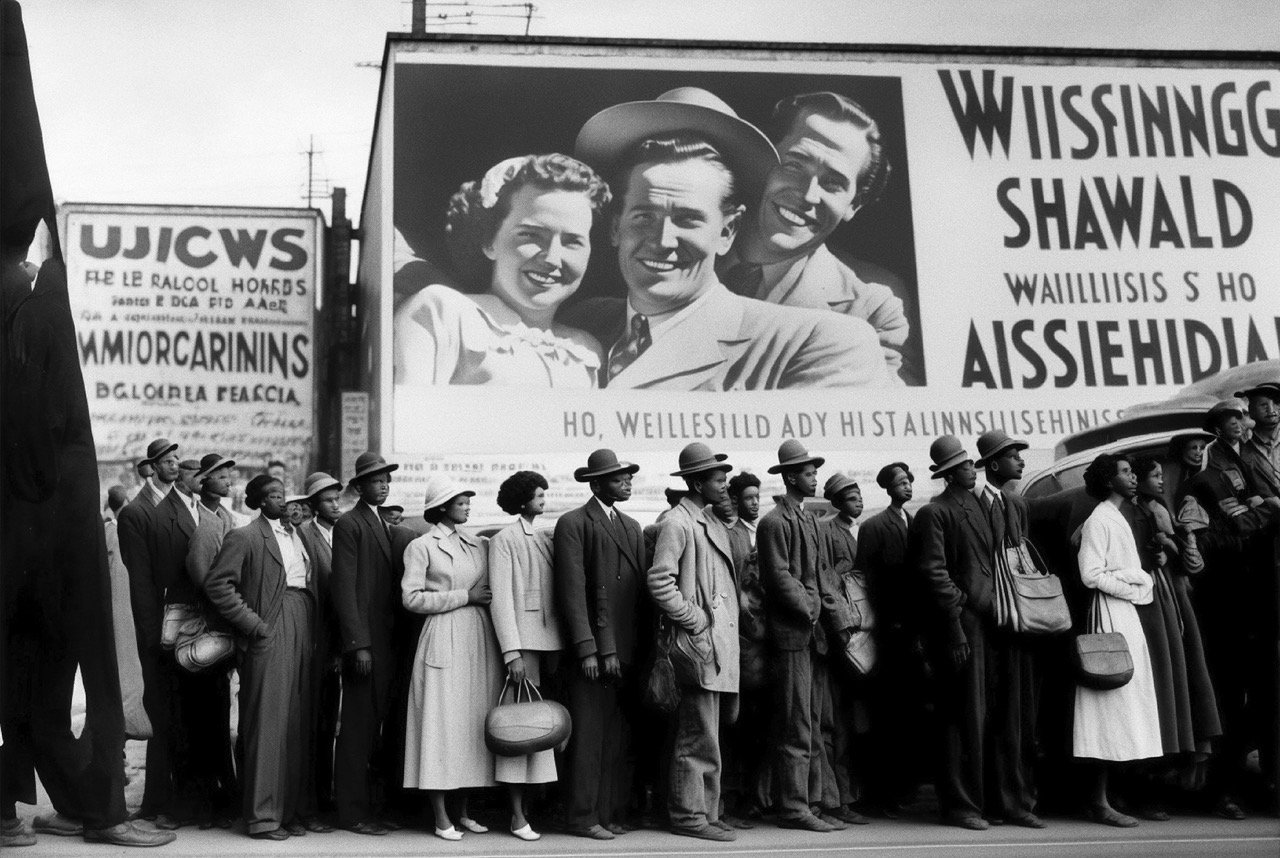





Thibaut Wychowanok
NUMERO ART
Article Exposition à la Galerie Papillon, Paris 2023.
ENGLISH/
For several months, artist duo Simon Brodbeck and Lucie de Barbuat have trained an artificial intelligence to “reenact” the most famous images of the 20th century. Historical, documentary and fashion photographs are recreated by the machine to offer confusingly lifelike fakes... and, even more disturbing sometimes, to produce some rewritten versions of history. Historical truths are falsified at times, while racist and sexist representations are exacerbated. This fascinating dive into the mechanisms of AI is to be discovered until January 13th, 2024, at the Papillon Gallery in Paris.
Three Soviet soldiers tower over the ruined city of Berlin, proudly displaying the red flag at the top of the Reichstag building. Captured on May 2nd, 1945, the photograph immediately went down in history. Since then, it has symbolized both the defeat of the Nazis and the power of propaganda in school textbooks. At the Papillon Gallery in Paris, that familiar image reemerges in an intriguing manner - a disquieting strangeness, surely due to the presence of the main character, who seems to be drawn, while the foreground is hyper-realistic. Actually, where are his two sidekicks?
This image is in fact a creation of the artificial intelligence Midjourney, which allows anyone to produce images from text descriptions. The artistic duo Brodbeck and de Barbuat fed content to the machine for several weeks to recreate multiple iconic snapshots of the 20th century. As the name of the original photographer was never mentioned to the AI, the French artists only provided the best textual description they could of what was represented in the first version. For the visitor, the exercise turns into both a game of the 7 errors and a game of reflection - what do we really remember when we are overflowing with images from our collective visual memory? One detail should have immediately stood out here. The red flag is not adorned with the usual Soviet emblems. The hammer and sickle are reinterpreted by the machine as symbols more akin to Japanese Kanji. “Artificial intelligence is more than capable of recreating a flag, a sickle and a hammer,” Simon Brodbeck declares jokingly. “Yet it has been limited by man. Its creators have especially forbidden it from representing any form of ideology or propaganda. That way, the AI considers the Soviet flag as such and therefore refuses to represent it... Whereas reproducing the American flag is not a problem.” Needless to mention that Midjourney is an American company...
Ironically, the photograph taken in May 1945 had also been edited before its publication. One of the three Soviet servicemen proudly sported a watch on each wrist, and to avoid any accusation of looting, they had been erased from the final picture... The art of editing images used to be Stalin’s speciality. He would edit his face to give it a smooth appearance and conceal his skin condition, which had been damaged by smallpox when he was a child, or, more seriously, he would remove former comrades, who fell victim to his purges, from official group pictures. Historical falsification didn’t wait for artificial intelligence. As photography aficionados, the duo Simon Brodbeck and Lucie de Barbuat are well aware that an image is everything but neutral. Their aim today is to dissect that lack of neutrality at the heart of AI. “This power of falsification is not the responsibility of the machine,” Simon Brodbeck emphasizes, before adding: “It is a mere tool. Its biases come from the limits imposed by its human designers and the source images it has access to in order to generate its own visual content.”
Racist and sexist biases are among the best identified. For instance, Annie Leibovitz’s iconic portrait of John Lennon (naked) and Yoko Ono (clothed) is reinterpreted in a stereotypical way by artificial intelligence. John Lennon is now all dressed up, while Yoko Ono appears half-naked, with her buttocks visible. “It probably happened because the AI considered that, like in most existing images of this type available to it, women are more often naked than men,” Simon Brodbeck comments. Thus, a whole collective unconscious emerges within the exhibition, unveiled in a series of “synthetic” and problematic pictures.
The award for digital drift goes to an AI’s reinterpretation of a famous image shot by American photographer Margaret Bourke-White. Following the major flooding in Kentucky in 1937, the journalist captured several African-Americans queuing up in front of a relief station through her lens. In the background, a huge billboard advertised a rich, white family in a car with the double slogan: “World’s highest standard of living” and “There’s no way like the American way”. Reproduced by artificial intelligence, the white family of the advert appears clean-cut. Each member is distinct, each face is sharply defined. Yet the figures of the African Americans in the photo are much blurrier - their features are vague, even distorted, taking the shape of the worst racist caricatures from the 1930s. “This is a well-known limitation of artificial intelligence,” Simon Brodbeck shares. “We attribute it to the fact that there are fewer representations of black people in the data available to them at the moment. It is harder for them to draw their inspiration from it and create realistic faces.” Just as the algorithms of social media reinforce the prejudices of their users by suggesting content similar to the one already consumed in a downward spiral, the mechanisms of artificial intelligence as highlighted by Simon Brodbeck and Lucie de Barbuat worry as much as they fascinate. Yet, its technical virtuosity struggles to make us forget about an essential question: who’s in charge?
Thibaut Wychowanok.
FRENCH/
Pendant plusieurs mois, le duo d’artistes Simon Brodbeck et Lucie de Barbuat a exercé une intelligence artificielle à “recréer” les clichés les plus célèbres du XXe siècle. Photos historiques, documentaires ou de mode sont réinterprétées par la machine pour offrir des faux d’une ressemblance confondante... et, plus inquiétant, susciter à l’occasion une certaine réécriture de l’Histoire. Les vérités historiques y sont parfois falsifiées, les représentations stéréotypées et sexistes exacerbées. Une passionnante plongée dans les mécaniques de l’IA à découvrir à la galerie Papillon, à Paris, jusqu’au 13 janvier.
Trois soldats soviétiques dominent un Berlin ravagé, dressant fièrement le drapeau rouge au sommet du palais du Reichstag. Le cliché pris le 2 mai 1945 rentre immédiatement dans l’Histoire : il symbolisera désormais la défaite nazie autant que la puissance de la propagande dans les ouvrages scolaires. À la galerie Papillon, à Paris, l’image familière apparaît à nouveau. Elle intrigue : une inquiétante étrangeté qui tient sans doute à ce personnage principal qu’on dirait dessiné alors que le premier plan paraît au contraire hyperréaliste. Où sont d’ailleurs ses deux acolytes ?
Cette image est en fait une création de l’intelligence artificielle Midjourney, qui permet de créer des images à partir de descriptions textuelles. Le duo d’artistes Brodbeck et de Barbuat a alimenté pendant plusieurs semaines la machine afin qu’elle reproduise des clichés iconiques du XXe siècle. Le nom du photographe n’étant jamais mentionné, les Français se sont contentés de décrire au mieux – par les mots – ce qui était représenté sur l’image originelle. Pour le visiteur, l’exercice tient autant du jeu de réflexion (de quoi se souvient-on vraiment dans ce flux d’images issues de notre mémoire visuelle collective ?) que du jeu des 7 erreurs. L’une d’elles aurait dû sauter aux yeux immédiatement : ici, le drapeau rouge n’est pas orné des habituels emblèmes soviétiques : la faucille et le marteau sont réinterprétés par la machine sous la forme d’un symbole tenant plus du kanji japonais. “L’intelligence artificielle est tout à fait capable de recréer un drapeau, une faucille et un marteau, s’amuse Simon Brodbeck. Mais elle a été limitée par l’homme : ses créateurs lui ont notamment interdit toutes formes de représentations idéologiques ou de propagande. L’IA, ainsi briefée, considère le drapeau soviétique comme tel et se refuse donc à le représenter… Alors que le drapeau américain ne pose, lui, aucun problème.” Est-il besoin de préciser que Midjourney est une entreprise américaine ?
Ironie de l'histoire, l'image de mai 1945 avait, elle aussi, été retouchée avant publication. L'un des trois militaires soviétiques arborait fièrement une montre à chaque poignet. Mais celles-ci avaient été effacées afin d'éviter toute accusation de pillage... Une pratique de la retouche d'image dont Staline se fit une spécialité : visage lissé pour dissimuler sa peau grêlée par la variole dans son enfance ou, plus sérieusement, effacement, sur les clichés de groupe officiels, de ses anciens camarades devenus victimes de ses purges. La falsification historique n'a pas attendu l'intelligence artificielle. Passionnés de photographie, le duo Simon Brodbeck et Lucie de Barbuat sait bien qu’aucune image n’est neutre et tend aujourd’hui à disséquer cette absence de neutralité au cœur de l’IA. “Ce pouvoir de falsification n'est pas de la responsabilité de la machine, insiste Simon Brodbeck. Elle n'est qu'un outil. Ses biais proviennent des limites imposées par ses créateurs humains et des sources d'images auxquelles elle a accès pour générer les siennes.”
Les biais racistes et sexistes sont parmi les mieux identifiés. Ainsi, le portrait iconique de John Lennon (nu) et Yoko Ono (habillée) par Annie Leibovitz est réinterprétée par l'intelligence artificielle de manière caricaturale. Désormais, John Lennon est vêtu et Yoko Ono les fesses à l'air. “Sans doute, commente Simon Brodbeck, parce l'IA a considéré que, dans la plupart des images existantes de ce type auxquels elle a accès, la femme est plus dénudée que l'homme...” C'est ainsi tout un inconscient collectif qui émerge au sein de l’exposition, révélé dans un précipité d’images “synthétiques” et problématiques.
La palme de la dérive numérique revient à la réinterprétation par l'IA d'un cliché célèbre de l'Américaine Margaret Bourke-White. Suite à d'importantes inondations dans le Kentucky en 1937, la journaliste photographie plusieurs Africains-Américains faisant la queue devant un organisme de secours. En arrière-plan, une immense publicité représente une famille blanche aisée, en voiture, accompagnée d’un double slogan : “Le niveau de vie le plus élevé au monde” et “Il n'y a rien de tel que le mode de vie américain”. Réinterprétée par l'intelligence artificielle, la famille blanche de la publicité apparaît nette. Chaque membre est distinct, chaque visage est précis. Mais les Africains-Américains sont beaucoup plus flous, leurs visages indistincts voire déformés à la manière des pires caricatures racistes des années 30. “Il s'agit d'une limite bien connue des intelligences artificielles, commente Simon Brodbeck. On l'attribue au fait que les représentations de personnes noires sont moins nombreuses dans les data auxquels elles ont accès aujourd'hui. Il est plus difficile pour elles de s'en inspirer et de créer des visages réalistes.” À l'image des algorithmes des réseaux sociaux renforçant les préjugés de leurs utilisateurs (en proposant des contenus identiques à ceux déjà consommés dans une boucle infernale), l'intelligence artificielle telle que dévoilée dans ses mécaniques par Simon Brodbeck et Lucie de Barbuatinquiète autant qu'elle fascine. Sa virtuosité technique peine pourtant à nous faire oublier une question essentielle : qui est aux manettes ?
Thibaut Wychowanok.